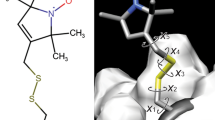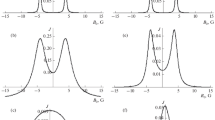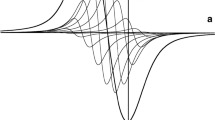Abstract
A method for the determination of number of spins from EPR spectra with a high level of noise is proposed. The method is based on a convolution of the experimental spectrum with the spectrum of the same shape characterized by a high signal-to-noise ratio. It was shown that the convolution technique is rather robust to the presence of additive noise in examined EPR spectrum.











Similar content being viewed by others
References
J.E. Wertz, J.R. Bolton, Electron Spin Resonance (Elementary Theory and Practical Applications. McGraw Hill Book Co., New York, 1972)
A.N. Kuznetsov, The Method of Spin Probes (Nauka, Moscow, 1976)
L.J. Berliner (ed.), Spin Labeling. Theory and Applications (Academic Press, New York, 1976)
G.I. Likhtenshtein, The Method of Spin Labels in Molecular Biology (Nauka, Moscow, 1974)
M. Drescher, G. Jeschke (eds.), EPR Spectroscopy: Applications in Chemistry and Biology (Springer, Heidelberg, New York, 2012)
G.R. Eaton, S.S. Eaton, D.P. Barr, R.T. Weber, Quantitative EPR (Springer, Vienna, 2010)
N.A. Chumakova, T.A. Ivanova, E.N. Golubeva, A.I. Kokorin, T Appl. Magn. Reson. 49, 511–522 (2018)
M. Srivastava, C.L. Anderson, J.H. Freed, IEEE Access 4, 3862–3877 (2016)
ChE Cook, M. Bernfeld, Radar Signals (Academic Press, New York, London, 1967)
M.I. Skolnik, Radar Handbook (McGraw-Hill, Boston, 1990)
G.A. Korn, T.M. Korn, Mathematical Handbook (Nauka, Moscow, 1984)
A.I. Smirnov, R.L. Belford, J. Magn. Reson. A 190, 65–73 (1995)
D.R. Duling, J. Magn. Reson. B 104, 105–110 (1994)
W.R. Dunham, J.A. Fee, L.J. Harding, H.J. Grande, J. Magn. Reson. 40, 351–359 (1980)
N.D. Yordanov, Appl. Magn. Reson. 6, 241–257 (1994)
N.D. Yordanov, M. Ivanova, Appl. Magn. Reson. 6, 333–340 (1994)
A.Kh. Vorobiev, N.A. Chumakova, in Nitroxides Theory, Experiment and Applications, ed. by A.I. Kokorin (INTECH, Rijeka, 2012), pp. 57–112
D.J. Schneider, J.H. Freed, in Biological Magnetic Resonance, vol. 8, ed. by L.J. Berliner, J. Reuben (Plenum, New York, 1989), pp. 1–76
D.A. Chernova, A.Kh. Vorobiev, J. Appl. Polym. Sci. 121, 102–110 (2011)
D.A. Chernova, A.K. Vorobiev, J. Polym. Sci. Part B Polym. Phys. 47(2009), 107–120 (2009)
Yu.N. Molin, K.M. Salikhov, K.I. Zamaraev, Spin Exchange (Springer-Verlag, Berlin, New York, 1980)
K.M. Salikhov, Appl. Magn. Reson. 38, 237–256 (2010)
B.Y. Mladenova, N.A. Chumakova, V.I. Pergushov, A.I. Kokorin, G. Grampp, D.R. Kattnig, J. Phys. Chem. B 116, 12295–12305 (2012)
M. Santoro, S.R. Shah, J.L. Walker, A.G. Mikos, Adv. Drug Deliv. Rev. 107, 206–212 (2016)
N.V. Minaev, Patent registration number 147199, Russia (2014)
Acknowledgements
This work was supported by the Russian Foundation of Basic Research (grants 14-33-00017-п, 18-29-06059, 17-02-00445) and partially by Lomonosov Moscow State University Program of Development.
Author information
Authors and Affiliations
Corresponding author
Additional information
Publisher's Note
Springer Nature remains neutral with regard to jurisdictional claims in published maps and institutional affiliations.
Appendices
Appendix 1
As an additive noise is considered, the distorted signal was calculated as follows:
\(I_{\text{noise}} \left( B \right)\) consists of randomly generated values in every point. In corresponding numerical tests, there is no relative shift of standard and experimental signals, so the maximum value of convolution function is at the point B = 0.
We compared this value with another one obtained when noise is equal zero, i.e. when standard spectrum is convolved with itself (MaxConv0); besides, we calculated the relative deviation of MaxConv (Dev):
As follows from Eq. (26), the value of Dev is different for different functions of \(I_{\text{noise}} (B)\), i.e. for different noise scattering along the spectrum. For example, the structure of noise is not changed, if \(I_{\text{noise}}\) is multiplied by (− 1) and in agreement with Eq. (2), Dev also inverses its sign. The latter means that the mathematical expectation of Dev can be zero.
In the real experiment, the point B = 0 cannot be determined exactly. In such a case, the maximal value of convolution function is taken as MaxConv. This leads to a slight shift of mathematical expectation of Dev to a positive area. Figure 12 presents the MaxConv deviation in the first numerical experiment (triplet spectrum, a = 17 G, \(\Delta B_{\text{pp}}\) = 1.5 G 2000 tries of noising) for SNR 20 (a) and 0.5 (b) with automatically measurement of MaxConv as a maximum of convolution function.
Appendix 2: Dependence of MaxConv Deviation vs Broadening of EPR Spectra
In the text above, we discussed the deviation of calculated MaxConv from its true value, if the linewidths of standard and experimental spectra are not coincided. Gaussian and Lorentzian profiles were considered. In many cases, line shapes are the convolution of Gaussian and Lorentzian functions [Voigt profile, V(B)]. Therefore, the Voigt profile is characterized by two parameters which are denoted here as \(\sigma_{\text{G}}\) and \(\sigma_{\text{L}}\). These parameters reflect the Gaussian and Lorentzian contribution to the line shape. In this appendix, the deviation of MaxConv in case of Voigt profile is considered.
Fourier-transform image of Voigt profile can be written in agreement with convolution theorem:
For convenience, we change the designation. Further, we put \(\sigma = \sigma_{\text{G}} , \;\;\delta = \sqrt 3 \sigma_{\text{L}}\). Hence, the convolution of two Voigt profiles is as follows:
where \(\Delta = \delta_{\text{st}} + \delta_{\exp } , \varSigma^{2} = \sigma_{\text{st}}^{2} + \sigma_{\exp }^{2}\).
If the line shape is not changed with broadening, i.e. Gaussian and Lorentzian contribution to the Voigt profile remains the same, we can take \(\alpha = \delta_{\exp } /\delta_{\text{st}} = \sigma_{\exp } /\sigma_{\text{st}} = \Delta B_{\text{pp}}^{\exp } /\Delta B_{\text{pp}}^{\text{st}}.\). Finally, the expression of the MaxConv deviation can be deduced:
Herein \(t = \frac{{\delta_{\text{st}} }}{{\sigma_{\text{st}} }},\;\;\xi = \frac{1 + \alpha }{{\sqrt {1 + \alpha^{2} } }}\) and \(f\left( t \right) = \sqrt {2\pi } \exp \left( {t^{2} } \right){\text{erfc}}\left( t \right)\left( {2t^{2} + 1} \right) - 2\sqrt 2 t\). Note, that the parameter t points out the contribution of components to the Voigt profile, e.g. t = 0 is regarded as the Gaussian case and \(t = \infty\) as the Lorentzian one. Analysis of Eq. (30) is rather complicated but it can be found (at least, graphically) that for any \(\alpha\) (hence, for any fixed broadening) \({\text{Deviation}}_{\text{V}}\) is the monotonic function of parameter t and is changed from Gaussian limit (15a) to Lorentzian one (15b). Moreover, for any t (that means for any Voigt profile):
One can use the first summand only with the minimum error for \(\alpha\) in the range [0.83, 1.20]. It should be noted that it is not always possible to estimate the parameters \(\sigma_{\text{G}}\) and \(\sigma_{\text{L }}\) in experiments. However, if \(\alpha > 1\), the difference between Gauss and Lorentz corrections is far less than the error of Q-factor measurement. This means that the formula (15a) or (15b) is acceptable in case of Voigt profile.
Rights and permissions
About this article
Cite this article
Chumakova, N.A., Kuzin, S.V. & Grechishnikov, A.I. Spectral Convolution for Quantitative Analysis in EPR Spectroscopy. Appl Magn Reson 50, 1125–1147 (2019). https://doi.org/10.1007/s00723-019-01133-9
Received:
Revised:
Published:
Issue Date:
DOI: https://doi.org/10.1007/s00723-019-01133-9





